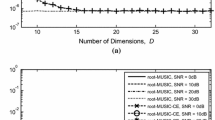Abstract
This paper deals with narrowband interference (NBI) and multiple access interference (MAI) suppression based on subspace-based approaches for direct-sequence code-division multiple-access (DS-CDMA) systems. First, the signal subspace-based and the interference subspace-based techniques are developed to estimate the noisy DS-CDMA signal and the interference signal, respectively. In conjunction with a modified multiple constrained minimum variance multiuser detector, we develop two efficient schemes to deal with the NBI and MAI that do not need any prior knowledge about the characteristics of the interference and specific training sequence. Next, an adaptive implementation based on a signal subspace tracking algorithm and a recursive least mean square algorithm is also developed. Several computer simulation examples in terms of bit error rate are provided for illustrating the effectiveness of the proposed schemes.
Similar content being viewed by others
References
Poor H.V., Xiaodong W. (1998) Blind adaptive suppression of narrowband digital interferers from spread spectrum signals. Wireless Personal Communications 6: 69–96
Shah A., Haimovich A.M. (1998) Space-time optimum combining for CDMA overlay for personal communications systems. Wireless Personal Communications 6: 295–309
Deng J.H., Lee T.S. (2002) A space-time multi-carrier CDMA receiver with blind adaptive MAI suppression. IEICE Transactions on Communications E 85(8): 1490–1498
Poor H.V., Wang X. (1997) Code-aided interference suppression for DS/CDMA communications—Part I: Interference suppression capability. IEEE Transactions on Communications 45(9): 1101–1111
Li L.M., Milstein L.B. (1984) Rejection of narrow-band interference in PN spread-spectrum system using transversal filters. IEEE Transactions on Communications 30(5): 925–928
Li, K. H., & Kot, A. (1994). Performance of rejection filters in DS spread spectrum systems. In IEEE International Conference Communication Systems (Vol. 2, pp. 359–363).
He, Y., Lei, S. F., Das, P., & Saulnier, G. J. (1988). Suppression of narrowband jammers in a DS spread spectrum receiver using modified adaptive filtering technique. In IEEE Global Telecommunications Conference (Vol.1, pp. 540–545).
Doherty J.F. (1998) A regularized LMS algorithm for narrowband interference rejection in direct sequence spread spectrum communications. Wireless Personal Communications 7: 53–67
Vijayan R., Poor H.V. (1990) Nonlinear techniques for interference suppression in spread-spectrum systems. IEEE Transactions on Communications 38(7): 1060–1065
Liu, F., & Garth, L. M. (2005). Dynamic convergence analysis of adaptive nonlinear filters for narrowband interference rejection in spread spectrum systems. In International Symposium on Information Theory (pp. 1696–1700).
The, K. C., Teng, C. C., Kot, A. C., & Li, K. H. (1995). Jammer suppression in spread spectrum. In IEEE International Conference Networks and Information Engineering (pp. 220–224). Singapore.
Ho K.C., Lu X., Meths V. (2007) Adaptive blind narrowband interference cancellation for multi-user detection. IEEE Transactions on Wireless Communications 6(3): 1024–1033
Poor H.V., Wang X. (1997) Code-aided interference suppression for DS/CDMA communications—Part II: Parallel blind adaptive implementations. IEEE Transactions on Communications 45(9): 1112–1122
Thomas J., Geraniotis E. (2001) Joint iterative multiuser and narrowband interference suppression in coded asynchronous DS-CDMA channels. Wireless Personal Communications 16: 69–92
Rusch L.A., Poor H.V. (1994) Narrowband interference suppression in CDMA spread spectrum communications. IEEE Transactions on Communications 42(2/3/4): 1969–1979
Tazebay M.V., Akansu A.N. (1998) A performance analysis of interference excision techniques in direct sequence spread spectrum communications. IEEE Transactions on Signal Processing 46(9): 2530–2535
Johnston L., Krishnamurthy V. (1999) Hidden Markov model algorithms for narrowband interference suppression in CDMA spread spectrum systems. Signal Processing 79: 315–324
ALshebeili S.A., Al-Qurainy A.M., Al-Ruwais A.S. (1999) Nonlinear approaches for narrowband interference suppression in DS spread spectrum systems. Signal Processing 77: 11–20
Wang C.L., Wu K.M. (2001) A new narrowband interference suppression scheme for spread-spectrum CDMA communications. IEEE Transactions on Signal Processing 49(11): 2832–2838
Chern S.J., Chang C.Y. (2002) Adaptive linearly constrained inverse QRD-RLS beamforming algorithm for moving jammers suppression. IEEE Transactions on Antennas and Propagation 50(8): 1138–1150
Yuan J. T., Lee J.N. (2003) Narrow-band interference rejection in DS/CDMA systems using adaptive (QRD-LSL)-based nonlinear ACM interpolators. IEEE Transactions on Vehicular Technology 52(2): 374–379
Chen D.S., Roy S. (1994) An adaptive multiuser receiver for CDMA systems. IEEE Journal on Selected Areas Communications 12(5): 808–816
Wax M., Kailath T. (1985) Detection of signals by information theoretic criteria. IEEE Transactions on Acoustics, Speech, Signal Processing 33(2): 387–392
Haykin S. (2001) Communication systems (4th ed). Wiley, New York
Chen Y.H., Chang A.C. (1999) Blind adaptive multiuser detection for DS/CDMA over fading channel. Electronics Letters 35(22): 1907–1909
Wang X., Poor H.V. (1998) Blind adaptive multiuser detection: A subspace approach. IEEE Transactions on Information Theory 44(2): 667–690
Godara L.C. (1990) Improved LMS algorithm for adaptive beamforming. IEEE Transactions on Antennas and Propagation 38(10): 631–1635
Yang B. (1995) Projection approximation subspace tracking. IEEE Transactions on Signal Processing, 43(1): 95–107
Haykin S. (2002) Adaptive filter theory (4th ed). Prentice-Hall, Upper Saddle River, NJ
Proakis J.G. (1995) Digital communications (3rd ed). McGraw-Hill., New York
Author information
Authors and Affiliations
Corresponding author
Rights and permissions
About this article
Cite this article
Chang, AC. Subspace-Based Schemes for NBI and MAI Suppression in DS-CDMA Communications. Wireless Pers Commun 50, 381–399 (2009). https://doi.org/10.1007/s11277-008-9611-1
Received:
Accepted:
Published:
Issue Date:
DOI: https://doi.org/10.1007/s11277-008-9611-1




